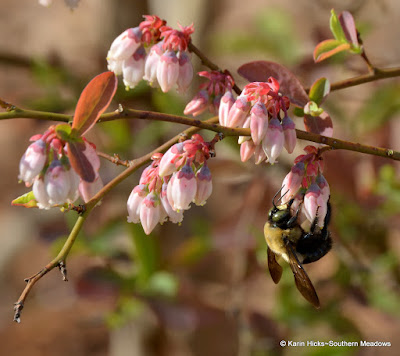Blueberries in Spring
My guilty pleasure is a cup of coffee every afternoon. It gets me through that 3 pm slump and almost human until bedtime. Today
as I sit with my coffee mug in hand, exhausted from a full day of garden clean up, I am being serenaded by
the frogs in our pond. In the distance I hear a pileated woodpecker fervently banging its head against a tree, either in search of food or constructing a nesting cavity, while a Carolina wren is singing his lungs out from a nearby redbud that recently burst into bloom. The layers of
sound in our spring garden are intoxicating and although my legs and feet are aching from a strenuous day, I sit soaking it all in.
I savor early spring, as each day brings a new discovery. This past week the blueberry buds burst into bloom and, according to my garden calendar, this means it’s officially spring in my part of the world.
Our native pollinators agree. The Southeastern blueberry bees, the most efficient pollinator of
our highbush and rabbiteye blueberries, are busily buzzing around the newly opened blooms, feeding on their rich nectar buffet. Specialists, they forage primarily on blueberries
and are only active for a short period of time during mid-March to April when
the blueberries are blooming.
We have 15 blueberry shrubs on our property, each plant producing thousands
of flowers. Each flower, a potential berry. Such demanding pollination services requires the work of a female blueberry bee who can be responsible for the production of 6,000 blueberries!
But these bees are not the only visitors. Other native pollinators, including clearwing moths, butterflies, bumblebees, and carpenter bees, take advantage of these early flowers.
The Eastern Tiger Swallowtail is one of the first butterflies to appear in March, just when two of its host plants, the tulip (Liriodendron) and wild cherry (prunus) trees start to leaf out. I frequently find these swallowtails camped out on the creeping phlox or blueberry shrubs this early in the season.
They maneuver around the dangling blooms positioning themselves at various angles to best reach their proboscis into the back of the flowers. This often means fighting wind gusts that launch them airborne, but these beauties are determined and gracefully dance their way to another flower.
They maneuver around the dangling blooms positioning themselves at various angles to best reach their proboscis into the back of the flowers. This often means fighting wind gusts that launch them airborne, but these beauties are determined and gracefully dance their way to another flower.
Early bloomers are a delight to behold, providing promise for a bountiful harvest. Come mid-summer we will be stuffing our mouths with fat, juicy berries and thanking these hard working pollinators.
Happy vernal equinox from our garden to yours!






.png)
